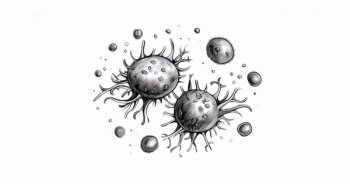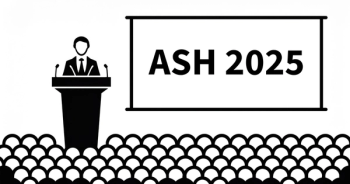
Case-Based Peer Perspectives Spotlight Live
- September 1 CBPP Spotlight
Ali Explores Pivotal Trial of Ruxolitinib in Acute GVHD
Haris Ali, MD, discussed the case of a 48-year-old patient with acute graft-versus-host disease.
Haris Ali, MD, associate clinical professor, Department of Hematology and Hematopoietic Cell Transplantation, City of Hope, Duarte, California, discussed the case of a 48-year-old patient with acute graft-versus-host-disease (aGVHD).
Targeted Oncology™: Would you describe the factors that contribute to the development of GVHD?
ALI: The donor-recipient factors include donor parity, donor age, and major and minor HLA [human leukocyte antigen]. Conditions that increase the risk of acute GVHD include using an HLA mismatched donor versus a matched donor, having an unrelated donor versus a related donor, multiparity versus nulliparity, and older donor versus younger donor.
Please share your thoughts on the answers provided.
You may be able to do more than 1 of these simultaneously. The patient was having difficulty, experiencing both diarrhea and the skin rash, with a BSA of 60%, so initiating steroid therapy and concurrently doing a biopsy would be something that most of us would do. I don’t see anyone recommending diarrhea prophylaxis or doing tests for GVHD biomarkers and waiting for that result
Are any systemic agents suggested for treating steroid-refractory acute GVHD?
Several agents are being used and recommended by the NCCN [National Comprehensive Cancer Network] guidelines.1
The treatment of GVHD is challenging, and [there are] complications of GVHD, especially for patients who are steroid refractory, with increasing immunosuppression. Mortality usually increases because of GVHD, but all the other complications and infections that we see add to the disease burden. There are many ongoing clinical trials, so I think that the field is changing quite rapidly.
In the past year, the FDA approved ruxolitinib [Jakafi] for the treatment of steroid-refractory GVHD in adults and in pediatric patients over the age of 12.2 Approval was based on study INCB 18424-271 [REACH-1; NCT02953678], an open-label, single-arm, multicenter trial involving 49 patients.
Treatments for acute GVHD include alemtuzumab [Lemtrada], α1-antitrypsin, anti-ATG [antithymocyte globulin], basiliximab [Simulect], calcineurin inhibitors, etanercept [Enbrel], photopheresis, and ruxolitinib.
What were the top-line results in the REACH2 trial?
The REACH2 study [NCT02913261] led to the approval of ruxolitinib in this setting.3 The crossover trial looked at overall survival and event-free survival. The primary end point, or the overall response rate at day 28, was 62% compared with the best available therapy, and the odds ratio [OR] was 2.64. There were more complete responses [CRs] and partial responses [PRs] in the ruxolitinib versus the control arm.
Regarding the durability of responses, if you look at responses at day 56, ruxolitinib was 40% compared with the control of 22%. Patients who had a CR had more durability compared with patients who had a PR [OR, 2.38; 95% CI, 1.43-3.94; P <.001].
Durable overall response rate at day 56 was higher in the ruxolitinib group [40%; 61 patients] than in the control group [22%; 34 patients; OR, 2.38; 95% CI, 1.43-3.94; P <.001]. The estimated cumulative incidence of loss of response at 6 months was 10% in the ruxolitinib group and 39% in the control group.
Looking at failure-free survival, patients in the ruxolitinib arm had a higher rate compared with the control arm, where the median was 5 months compared with 1 month in the best available treatment arm [HR, 0.46; 95% CI, 0.35-0.60].
Adverse effect profile was somewhat difficult to gauge. Some of the on-target effects include cytopenias, thrombocytopenia, anemia, CMV [cytomegalovirus] reactivation, CMV infections, peripheral edema, and neutropenia. These are commonly seen, but cytopenias are probably an on-target effect of the JAK inhibition.
References:
1. NCCN. Clinical Practice Guidelines in Oncology. Hematopoietic cell transplantation (HCT): Pre-transplant recipient evaluation and management of graft-versus-host disease, version 2.2020. Accessed August 28, 2020. http://bit.ly/34HbvW4
2. FDA approves ruxolitinib for acute graft-versus-host disease. FDA. Updated May 24, 2019. Accessed August 28, 2020. http://bit.ly/3hH9GMv
3. Zeiser R, von Bubnoff N, Butler J, et al; REACH2 Trial Group. Ruxolitinib for glucocorticoid-refractory acute graft-versus-host disease. N Engl J Med. 2020;382(19):1800-1810. doi:10.1056/NEJMoa1917635
Articles in this issue
about 5 years ago
Gergis and Rowley Examine Treatment of Moderate Chronic GVHDabout 5 years ago
Pro Talks Treatment for Peripheral T-Cell Lymphomaabout 5 years ago
Khan Implements a Treatment Plan for a Patient With CLLabout 5 years ago
Ghosh Addresses Brentuximab Vedotin Use in Advanced Hodgkin Lymphomaabout 5 years ago
Sandoval Sus Treats a Patient With Chronic Lymphocytic Leukemia







































